#DomainTools
Explore tagged Tumblr posts
Text
Хакеры FIN6 атакуют рекрутеров с помощью поддельных резюме
New Post has been published on https://er10.kz/read/it-novosti/hakery-fin6-atakujut-rekruterov-s-pomoshhju-poddelnyh-rezjume/
Хакеры FIN6 атакуют рекрутеров с помощью поддельных резюме

Хакеры из известной группировки FIN6 придумали новую схему взлома – они маскируются под соискателей работы для атак на рекрутеров с помощью вредоносно��о ПО.
Связываясь с HR-отделами на сайтах вроде LinkedIn или Indeed, хакеры отправляют поддельные резюме, содержащие фишинговые ссылки. Они ведут на якобы «личный сайт» соискателя. Ссылки представлены в формате личных сайтов «johnsmith.com».
– Поддельные ссылки созданы таким образом, чтобы обходить обнаружение и блокировку, требуя от получателей вручную вводить их в браузере, – говорит менеджер команды исследования AttackIQ Эндрю Костис. – Домены регистрируются анонимно и оснащены системами снятия цифровых отпечатков окружения и поведенческими проверками, чтобы гарантировать, что только цель может открыть целевые страницы.
В новом отчете DomainTools исследователи выявили ряд таких доменов, размещенных на инфраструктуре AWS, включая bobbyweisman.com, emersonkelly.com и davidlesnick.com.
– Вероятно, злоумышленники, стоящие за этими доменами, используют одноразовые или поддельные адреса электронной почты, анонимные или зарубежные IP-адреса, а также украденные способы оплаты для создания и поддержания этих аккаунтов, – отметили исследователи.
DomainTools сообщила, что одной из любимых полезных нагрузок группы является more_eggs – скрытый JavaScript-бэкдор, разработанный группой Venom Spider.
Вредоносное ПО more_eggs способствует краже учетных данных, получению доступа к системам и последующим атакам, включая использование программ-вымогателей.
Группа FIN6 имеет в своем арсенале множество уловок и схем взлома. Она компрометировала POS-системы для финансового мошенничества, расширилась до атак программами-вымогателями и совсем недавно использовала кампании социальной инженерии для доставки JavaScript-бэкдоров как услуги для кражи учетных данных. Этот обширный опыт делает их особенно угрожающими для незащищенных данных.
0 notes
Text
More Elon Musk dog crew connection to organized cyber crime.
Reuters - Exclusive: DOGE staffer 'Big Balls' provided tech support to cybercrime ring, records show By Raphael Satter March 26, 202511:00 AM EDT Musk has championed the teen on his social media site X, telling his followers last month that "Big Balls is awesome." Beginning around 2022, while still in high school, Coristine ran a company called DiamondCDN, that provided network services, according to corporate and digital records reviewed by Reuters and interviews with half a dozen former associates. Among its users was a website run by a ring of cybercriminals operating under the name "EGodly," according to digital records preserved by the internet intelligence firm DomainTools and the online cybersecurity tool Any.Run. The details of Coristine's connection to EGodly have not been previously reported. On Feb. 15, 2023, EGodly thanked Coristine's company for its assistance in a post on the Telegram messaging app.
0 notes
Text
Unlocking SEO Potential: The Importance of a Domain Age Checker for Your Website
In the world of search engine optimization (SEO), numerous factors contribute to a website’s ranking on search engine results pages (SERPs). One such crucial factor is the age of the domain. Utilizing a domain age checker can provide valuable insights into your website’s standing and influence your SEO strategy.
This blog explores the significance of domain age, the benefits of using a domain age checker, and how to effectively incorporate this tool into your SEO efforts.

Understanding Domain Age
Domain age refers to the length of time a domain has been registered and active. It is a key indicator of a website’s longevity and trustworthiness. Search engines, particularly Google, often view older domains as more reliable and authoritative compared to newer ones, as they have had more time to build a solid reputation and accumulate quality backlinks.
Why Use a Domain Age Checker?
A domain age checker is a tool that allows you to determine the exact age of a domain. This information can be incredibly useful for several reasons:
1. SEO Analysis
Knowing the age of your domain can help you understand its potential impact on your SEO efforts. Older domains generally have an advantage in search rankings due to their perceived authority and trustworthiness.
2. Competitive Research
A domain age checker can be used to analyze your competitors' domains. By understanding the age of competing domains, you can gauge their authority and adjust your SEO strategies accordingly.
3. Investment Decisions
If you are considering purchasing an existing domain, a domain age checker can provide essential information about its history. Older domains with a clean history are often more valuable and can provide a head start in SEO.
4. Backlink Strategy
Older domains are likely to have accumulated more backlinks over time. By checking the domain age, you can better understand the backlink profile and develop a more effective link-building strategy.
How to Use a Domain Age Checker
Using a domain age checker is straightforward. Here’s a step-by-step guide:
1. Choose a Reliable Domain Age Checker
There are several domain age checker tools available online, such as Whois.net, DomainTools, and Webconfs. Select a reliable tool that provides accurate and detailed information.
2. Enter the Domain Name
Input the domain name you want to check. This could be your own domain or a competitor’s domain.
3. Analyze the Results
The domain age checker will provide the registration date, the age of the domain, and sometimes additional information such as the registration history and changes in ownership.
4. Incorporate Insights
Use the insights gained from the domain age checker to inform your SEO strategy. This could involve enhancing your link-building efforts, adjusting your content strategy, or making investment decisions.
Benefits of Knowing Domain Age
1. Enhanced Credibility
An older domain often enjoys enhanced credibility in the eyes of search engines and users. This can lead to higher rankings and increased traffic.
2. Improved SEO Strategy
Understanding the age of your domain can help you tailor your SEO strategy more effectively. For instance, older domains might benefit more from content updates and backlink maintenance, while newer domains may need to focus on building authority from scratch.
3. Better Competitive Analysis
By comparing the domain ages of your competitors, you can identify potential strengths and weaknesses in their SEO strategies. This can help you find opportunities to outperform them in search rankings.

Conclusion
A domain age checker is an invaluable tool for anyone serious about SEO. By understanding the age of your domain and those of your competitors, you can make informed decisions that enhance your website’s authority, improve your SEO strategy, and ultimately achieve better search engine rankings. Whether you are a seasoned SEO expert or a novice looking to improve your online presence, leveraging the power of a domain age checker can provide a significant advantage in the competitive digital landscape.
1 note
·
View note
Text
How to Secure a Domain the Moment It Expires: Insider Tips
Understanding the Domain Expiration Process
Before diving into the strategies for acquiring an expired domain, it’s important to understand the domain expiration process.

When a domain is not renewed by its owner, it doesn’t immediately become available. Instead, it goes through several stages:
Expiration: Initially, the domain is marked as expired but the original owner still has the chance to renew it.
Grace Period: Typically lasting about 30–45 days, during this time the owner can still renew the domain at the regular renewal price.
Redemption Period: If still not renewed, the domain enters a redemption phase where the owner can reclaim it, usually at a higher price.
Pending Delete: After the redemption period, the domain is scheduled for deletion and will soon be available for registration by the public.
Knowing these stages helps you time your attempt to secure the domain more accurately.
Tools and Resources for Tracking Expiring Domains
To secure a domain the moment it expires, you need the right tools. Here are a few recommended resources:
Domain Monitoring Services: Use services like DomainTools or NameJet to get alerts on domain status changes. These tools can notify you when a domain moves into the pending delete phase.
Auction and Backorder Services: Platforms like GoDaddy Auctions or SnapNames allow you to place a backorder on a domain. This means they will automatically attempt to register the domain on your behalf the moment it becomes available.
Strategies to Successfully Acquire an Expired Domain
Be Prepared
The key to successfully securing an expired domain is preparation. Ensure you have an account set up with a reliable domain registrar who can attempt to catch the domain as it drops. Funding your account in advance and having quick access to it during the crucial moment can make all the difference.
Use Automated Tools
Leverage automated tools provided by domain registration companies. These tools can attempt to register a domain the second it becomes available. Given the competitive nature of this process, having automated systems in place increases your chances of success.
Prioritize Speed
Speed is essential when trying to secure a domain as it expires. Ensure that the internet connection and tools you use are optimized for quick response and processing. Delays of even a few seconds can cost you a valuable domain.
Common Pitfalls to Avoid
While chasing expired domains, it’s easy to fall into some common traps:
Ignoring Legal Considerations: Always check if the domain name is trademarked or could potentially lead to legal issues.
Overpaying: Set a budget and stick to it. It’s easy to get caught up in the moment and spend more than what the domain is worth.
Neglecting Research: Thoroughly research the domain’s history to ensure it doesn’t have a problematic past, such as penalties or blacklists from search engines.
Find Killer Expired Domains with SEO Whiz on Konker.io
Ready to take your domain portfolio to the next level? Visit SEO Whiz on Konker.io to explore a curated selection of high-quality expired domains ready for acquisition. With SEO Whiz, you gain access to premium tools and expert insights to secure domains efficiently and effectively. Don’t miss out on the chance to own a powerful domain that could elevate your online presence.
Conclusion
Securing a domain as soon as it expires requires quick action, proper tools, and a bit of strategy. By understanding the expiration process, utilizing the right tools, and being prepared for quick execution, you can significantly increase your chances of acquiring valuable expired domains. Follow these insider tips and start building your domain portfolio today. Remember, every second counts in the competitive domain acquisition market!
0 notes
Text
WHOIS domain lookup serves as an indispensable tool for navigating the digital landscape, providing valuable insights into domain ownership, IP addresses, and DNS records. Whether you're a cybersecurity professional, a website owner, or simply curious about the inner workings of the internet, WHOIS domain lookup can empower you with knowledge and understanding. Know Domain Whois Lookup, ICANN Database, Domain Availability, Domain IP & DNS and Website owner details.
Get verified Whois information for any Domain Name, Check Domain Availability for FREE! Whois Lookup, Domain Availability & IP Search - DomainTools Check domain ownership with Website Whois Lookup: Get ownership information, IP address and Domain DNS.
0 notes
Text
Unlocking the Secrets of Domain Age: Your Guide to Using a Domain Age Checker
In the vast landscape of the internet, where new websites pop up daily and digital footprints are ever-evolving, the age of a domain plays a crucial role in determining its trustworthiness, authority, and search engine ranking. Understanding the concept of domain age and how to use a domain age checker is vital for webmasters, SEO experts, and anyone looking to assess the credibility and history of a website. In this article, we will unlock the secrets of domain age and provide a comprehensive guide on using a domain age checker effectively.

What Is Domain Age?
Domain age refers to the length of time a domain name has been registered and in use. It is typically measured from the date of registration or creation to the present day. Domain Age Finder is a factor that search engines and internet users consider when evaluating a website's authenticity, reliability, and relevance. While it's not the sole determinant of a website's quality, domain age can provide valuable insights.
Why Does Domain Age Matter?
Trust and Credibility: Older domains are often viewed as more trustworthy and credible by both search engines and users. They are seen as less likely to engage in spammy or fraudulent activities.
Search Engine Ranking: Search engines like Google consider domain age as one of the factors in their ranking algorithms. A domain with a longer history may have an advantage in search results.
Authority and Backlinks: Older domains tend to accumulate more backlinks over time. Backlinks are an essential component of SEO and contribute to a website's authority.
Content History: The age of a domain can provide insights into its content history, showing how long it has been publishing information on a particular topic or industry.
Brand Recognition: Well-established domains often have a stronger brand presence, which can positively impact user perception and engagement.
How to Use a Domain Age Checker:
Now, let's dive into how to use a domain age checker to unearth the age of a website's domain:
Select a Domain Age Checker:
There are several online tools and services that can provide domain age information. Popular choices include DomainTools, Whois.net, and ICANN Lookup, among others. Choose a reputable and user-friendly domain age checker.
Enter the Domain Name:
Visit the chosen domain age checker and enter the domain name (e.g., www.example.com) of the website you want to investigate. Click the search or lookup button to initiate the query.
View the Results:
The domain age checker will retrieve and display information about the domain's creation date or registration date. It may also provide additional details, such as the domain's expiration date and ownership information.
Interpret the Data:
Interpreting the data is key to understanding the significance of the domain's age. Consider the following:
Is the domain age consistent with the website's claimed history?
How long has the domain been registered?
Is the domain nearing its expiration date, which may suggest the website's future?
Use the Information Wisely:
The domain age is just one of many factors to consider when assessing a website. While it can provide insights into the website's history, it should be analyzed in conjunction with other factors, such as content quality, backlinks, and user engagement.
Our Service:-
Keyword Suggestion Features
Plagiarism Checker Small SEO
Sitemap XML Creator
Conclusion:
Domain age is a valuable metric for evaluating the credibility and authority of a website. Using a domain age checker is a straightforward process that can help webmasters, SEO professionals, and users gain a deeper understanding of a website's history and online presence. However, it's essential to remember that domain age is just one piece of the puzzle in the complex world of web assessment, and a comprehensive evaluation of a website should consider multiple factors for a more accurate judgment of its quality and trustworthiness.
Domain Age Finder
0 notes
Text
Tools und Strategien für die Suche nach gelöschten Domains in Ihrer Nische
Die Welt des Online-Marketings und des Domain-Handels ist ständig in Bewegung, und eine der spannendsten Möglichkeiten, die sich bietet, ist die Suche nach gelöschten Domains in Ihrer Nische. Eine gelöschte Domain kann ein wertvolles Gut sein, das es Ihnen ermöglicht, bereits etablierten Verkehr und Autorität zu nutzen, um Ihre Online-Präsenz zu stärken. In diesem Artikel werden wir uns mit Tools und Strategien befassen, die Ihnen bei der Suche nach gelöschten Domains in Ihrer Nische helfen.
Warum sind gelöschte Domains wichtig?
Authinfo-Code sind Internetadressen, die zuvor von ihren Besitzern aufgegeben wurden oder aus verschiedenen Gründen aus dem Netz verschwunden sind. Diese Domains können immer noch auf Suchmaschinenindexen und in Backlink-Profilen vieler Websites vorhanden sein. Das macht sie zu einer wertvollen Ressource für Online-Marketer und Geschäftsleute. Hier sind einige Gründe, warum gelöschte Domains wichtig sein können:

Vorhandener Verkehr: Gelöschte Domains können immer noch Verkehr von Suchmaschinen oder Verweisen von anderen Websites erhalten. Indem Sie eine solche Domain erwerben, können Sie diesen bestehenden Verkehr nutzen.
Autorität und Backlinks: Wenn eine gelöschte Domain in Ihrer Nische eine gute Backlink-Historie hat, kann sie Ihnen helfen, Ihre eigene Website schneller und effizienter zu bewerben.
Markenbildung: Sie können eine gelöschte Domain verwenden, um eine neue Website zu erstellen oder Ihre bestehende Marke zu stärken, da sie möglicherweise bereits in Ihrer Branche bekannt ist.
Jetzt, da Sie die Bedeutung von gelöschten Domains verstehen, lassen Sie uns einige Tools und Strategien erkunden, um sie zu finden.
Tools zur Suche nach gelöschten Domains
Domain-Auktionsplattformen: Plattformen wie GoDaddy, Sedo und NameJet bieten Auktionen für gelöschte Domains an. Hier können Sie nach Domains in Ihrer Nische suchen und Gebote abgeben.
Domain-Marktplätze: Es gibt Online-Marktplätze wie Flippa und eBay, auf denen gelöschte Domains zum Verkauf angeboten werden.
Domain-Monitoring-Dienste: Dienste wie DomainTools und ExpiredDomains.net bieten umfassende Listen gelöschter Domains an, die nach verschiedenen Kriterien durchsucht werden können.
Google Alerts: Erstellen Sie Google Alerts für Schlüsselwörter in Ihrer Nische, um benachrichtigt zu werden, wenn gelöschte Domains in den Suchergebnissen auftauchen.
Strategien zur erfolgreichen Suche nach gelöschten Domains
Festlegen von Kriterien: Definieren Sie klare Kriterien für die Art der gelöschten Domain, die Sie suchen. Dies kann die Domain-Autorität, das Alter der Domain und die Anzahl der Backlinks umfassen.
Keyword-Recherche: Verwenden Sie Tools wie den Google Keyword Planner, um relevante Schlüsselwörter in Ihrer Nische zu finden. Suchen Sie nach Domains, die diese Schlüsselwörter enthalten oder damit in Verbindung stehen.
Überwachen Sie die Konkurrenz: Beobachten Sie Ihre Wettbewerber und achten Sie darauf, ob sie gelöschte Domains in Ihrer Nische erwerben. Dies könnte ein Hinweis darauf sein, dass diese Domains wertvoll sind.
Prüfen Sie die Geschichte: Nutzen Sie Tools wie Wayback Machine, um die Geschichte einer gelöschten Domain zu überprüfen. Stellen Sie sicher, dass sie nicht mit negativen Inhalten oder Strafen in Verbindung steht.
Bieten Sie strategisch: Wenn Sie eine vielversprechende gelöschte Domain gefunden haben, bieten Sie strategisch auf sie. Berücksichtigen Sie Ihr Budget und Ihre langfristigen Ziele.
Rebranding und Content-Optimierung: Nachdem Sie eine gelöschte Domain erworben haben, überarbeiten Sie sie, um sie an Ihre Bedürfnisse anzupassen. Aktualisieren Sie den Inhalt, optimieren Sie die SEO und nutzen Sie die bestehenden Backlinks.
Fazit
Die Suche nach gelöschten Domains in Ihrer Nische kann eine lohnende Strategie sein, um Ihre Online-Präsenz zu stärken und von bestehendem Verkehr und Autorität zu profitieren. Mit den richtigen Tools und Strategien können Sie wertvolle Domains finden und erfolgreich in Ihre Online-Marketing-Strategie integrieren. Stellen Sie sicher, dass Sie Ihre Bemühungen sorgfältig planen und Ihre Ziele im Auge behalten, um die bestmöglichen Ergebnisse zu erzielen. Gern ist Ihnen dabei Onyxhosting.de als zuverlässiger Partner behilflich.
Für mehr Information. Besuchen Sie uns:
Authinfo2
Managed Nextcloud Hosting Deutschland
Nextcloud Hosting
Wordpress WebseiteNextcloud Hosting Deutschland
0 notes
Text
Phishing, Smishing Surge Targets USPS
Recent weeks have witnessed a significant increase in cyber-attacks targeting the US Postal Service (USPS), mainly through phishing and smishing campaigns. The surge in these attacks has prompted DomainTools researchers to delve into their origins and implications, with findings described in an advisory published on Thursday. One smishing message raised suspicions due to its peculiar language,…
View On WordPress
1 note
·
View note
Text
age checker domain
In the vast landscape of the internet, websites come and go, but some have been around for quite a while. Knowing the age of a domain can provide valuable insights into the credibility and trustworthiness of a website. Whether you're a curious internet user or a digital marketer conducting research, determining a domain's age is a useful skill. In this article, we will explore various methods to find out the age of a domain.
Use Domain Age Checker Tools:
Several online tools are designed specifically to check the age of a domain. These tools access domain registration records and provide information about when the domain was first registered. Popular domain age checker tools include Domain Age Checker by Small SEO Tools, Whois.net, and DomainTools. Simply enter the domain name, and the tool will retrieve the registration date for you.
Utilize WHOIS Lookup:
WHOIS is a database containing registration details of domain names, including their creation date. You can perform a WHOIS lookup by visiting websites like whois.icann.org or using domain registrar services like GoDaddy or Namecheap. Enter the domain name you want to investigate, and you'll find details about the domain's creation date, registrant information, and more age checker domain .
Check Archive.org:
The Wayback Machine, part of the Internet Archive, stores historical snapshots of websites. By entering the domain name into archive.org, you can see a timeline of how the website has evolved over the years. While this won't give you the exact registration date, it can help you estimate when the website first appeared on the internet.
Examine the Copyright Date:
Scroll down to the footer of the website you're interested in. Often, websites display a copyright notice that includes the year the website was created or the earliest content was published. While this date may not be the domain registration date, it can offer a clue about the website's age.
Analyze Google's Cached Pages:
Perform a Google search for "site:domain.com" (replace "domain.com" with the actual domain you're researching). Click on the search result, then select "Cached" to view a snapshot of the website as Google last crawled it. This can give you an idea of when Google first indexed the site, which may align with the domain's age.
Use SEO Tools:
Many SEO tools and platforms provide domain age information as part of their analysis. Tools like Moz, SEMrush, and Ahrefs offer domain age metrics alongside other SEO data. These platforms are especially useful for digital marketers and website owners looking to assess the competition.
Conclusion:
Determining the age of a domain is essential for various purposes, from assessing a website's credibility to conducting competitive research. You can use domain age checker tools, perform WHOIS lookups, explore archive.org, check copyright dates, analyze Google's cached pages, and leverage SEO tools to find this valuable information. Understanding a domain's age is just one step in evaluating its trustworthiness and historical significance on the internet.
1 note
·
View note
Text
0 notes
Link
Context
“Since April 15, protests against coronavirus lockdown measures have been sweeping across various American states. ... over 500 new domains related to the protests have been registered in the past month.”
“The largest number of them were created just hours after President Trump sent a series of all-caps tweets urging citizens to ‘liberate’ themselves from new gun control measures and state leaders who’ve enacted strict social distancing restrictions in the face of the COVID-19 pandemic.”
Suspicion
“A number of the state-based reopenmn[.]com or reopenmd[.]com domains were all registered on GoDaddy at the same time and within seconds of each other. This led them to suspect that the reopen America protests were not a grassroots campaign, but actually a coordinated astroturfing—or fake grassroots—effort.”
Research and Confirmation
According to DNS-focused cybersecurity firm DomainTools:
“By gathering domain names that include the same words, and by analysing the domains for other similarities, DomainTools was able to determine that many of them ‘redirect to a state-based firearms coalition group.’ ... these groups tie back to Aaron Dorr, a registered lobbyist for the state of Iowa. ... the ‘reopen’ websites linked to Aaron Dorr bear various similarities, including the fact that they were built using nonpartisan advocacy platform One Click Politics and also WordPress. By looking at one of them, the Iowa Gun Owners website, DomainTools was able to find Dorr’s telephone number. DomainTools then examined the historical SSL certificates used for each of the firearms advocacy domains, finding Mr. Dorr’s personal domain and also numerous other domains associated with other firearm’s coalitions elsewhere in the US. ... this ‘raised the likelihood for us that Mr. Dorr was the one running these campaigns.’ In other words, a batch of the ‘reopen America’ domains are the work of a single gun advocacy network.”
The full analysis from DomainTools is here.
Who Is This Guy?
Aaron Dorr and his brothers Chris, Matt, and Ben are infamous for capitalizing on fearmongering to fundraise hundreds of thousands of dollars for themselves. Even the staunchest supporters of the Second Amendment despise the Dorrs:
“They are not motivated by a genuine appetite for advancement of Second Amendment virtues ... They are there to stir the pot and make as much animosity as they can, and then raise money off that animosity.”
The Dorr brothers are so blatant that the Minnesota GOP--hardly a group of anti-gun liberals--sponsored an official website exposing them as “Minnesota Scammers” for creating a fake gun-rights group, a fake pro-life group, and two fake pro-Trump groups.
Another website devoted to “Exposing the Dorr Brother Scams” explains how the Dorrs rake in the profits from all of their supposed non-profits:
“Rent or sell themselves their own mailing lists”;
“Have their multiple non-profits purchase their adverising, print and mailing materials from their for-profit company”; and
“Pay themselves management fees”
The sites make for very educational reading.
#DomainTools#astroturfing#ReopenAmerica#conservatives#gun rights#gun advocacy#2nd Amendment#Second Amendment#Dorr#Aaron Dorr#American Firearms Coalition#Dorr brothers#Chris Dorr#Ben Dorr#Matt Dorr#scam
7 notes
·
View notes
Photo

"Park Soo-jin, a member of Keyeast Entertainment...is not retiring"...Bae Yong-joon, billions of times, is unlikely to return (Entertainment Weekly Plus')
Source: k-star-holic.blogspot.com
0 notes
Photo

КАКВО ТРЯБВА ДА ЗНАЕМ ЗА ДОМЕЙНА ПРЕДИ ДА ГО ЗАКУПИМ ? От Sky Prime Ви съветваме, преди да се сдобиете с нов домейн, да проучите дали в действителност е нов. Проверката може да направите чрез платформата www.domaintools.com, като тя ще Ви предостави информация свързана с миналото на домейна. В нея е необходимо да откриете дали той е употребяван и ако е ,каква е функционалноста която е извършвал преди.Това е важно за Вас за да избегнете бъдещи проблеми ако старото му съдържание е било свързано с нелегална информация,порнография и други. Прегледайте и за наличие на стари версии на домейна, които може да се съхраняват в www.archive.org. sky-prime.com - https://sky-prime.com/seo-off
0 notes
Photo

КАКВО ТРЯБВА ДА ЗНАЕМ ЗА ДОМЕЙНА ПРЕДИ ДА ГО ЗАКУПИМ ?
От Sky Prime Ви съветваме, преди да се сдобиете с нов домейн, да проучите дали в действителност е нов. Проверката може да направите чрез платформата www.domaintools.com, като тя ще Ви предостави информация свързана с миналото на домейна.
В нея е необходимо да откриете дали той е употребяван и ако е ,каква е функционалноста която е извършвал преди.Това е важно за Вас за да избегнете бъдещи проблеми ако старото му съдържание е било свързано с нелегална информация,порнография и други. Прегледайте и за наличие на стари версии на домейна, които може да се съхраняват в www.archive.org.
0 notes
Text
The BBC!Sherlock-affiliated websites: a look at the current WTFery...
Some thoughts about the current state of play, with a little under-the-hood sleuthing...
Let’s start with the one that’s least affected by the present changes (whatever they mean.) The Blog of Dr. John Watson, at http://www.johnwatsonblog.co.uk/, is still loading... though without formatting.
This kind of loss of format is well known among web designers as the Flash of Unstyled Content. When it happens for reasons we can’t work out, it drives us right around the bend. It is, however, also something that can happen when the person managing a website is changing the underlying “theme” that provides its user-facing look-and-feel.
So what does all this mean at the moment?
Difficult to say. Let’s take the diagnosis one step at a time.
Are we seeing current site output -- not something cached? The resource at DownForEveryoneOrJustMe (a good way to check server status) says that the site is live.

So far, so good. Now let's have a look at the information in the head of the webpage itself to see what it shows.
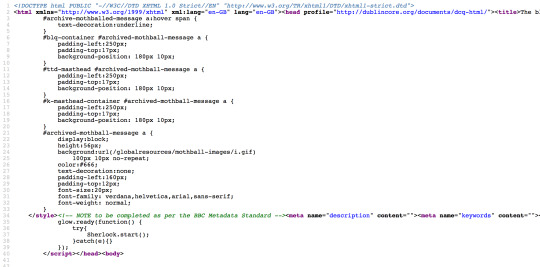
That info indicates a site that’s been designed and implemented by someone from the BBC. By itself, though, that doesn’t prove anything: someone else running the site might simply have left that information in place on an un-redesigned web page. So let’s doublecheck to see who presently owns the site by using the domain name info source Whois. (I’m using a version housed at DomainTools.)
That info looks like this:
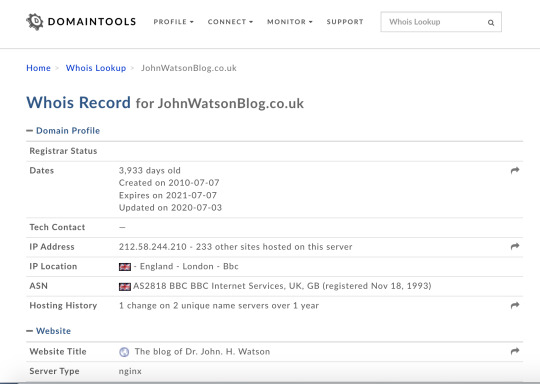
The IP addresses shown in the full WhoIs record indicate that this site is still housed on the BBC’s servers.
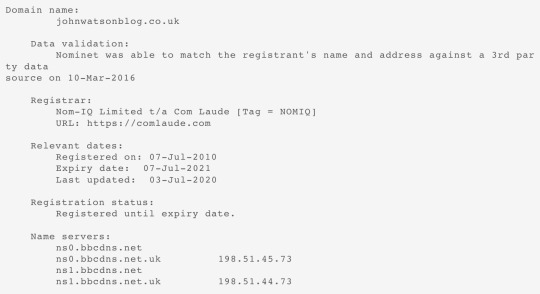
There’s an uncomfortable implication here, though. The domain name’s present registration only runs until July of this year. That things are starting to happen to the site now may mean that the BBC is preparing to relinquish the domain as something they don’t need any more (or don’t feel like paying to keep any more...).
So: let’s run the other site we’re mostly concerned about, Sherlock’s “The Science of Deduction” website, through the same process.
Here’s the metadata from the top of its front page.
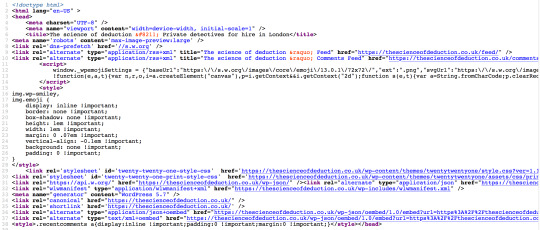
This (as far as I can tell) is the plain-vanilla page header of a default WordPress theme -- their “2021″ theme, specifically. The BBC would not be using WordPress. So we can safely deduce, immediately, that the BBC has at some point or another declined to re-register the “thescienceofdeduction.co.uk” domain, and someone else has bought it.
Doublechecking this at WhoIs:
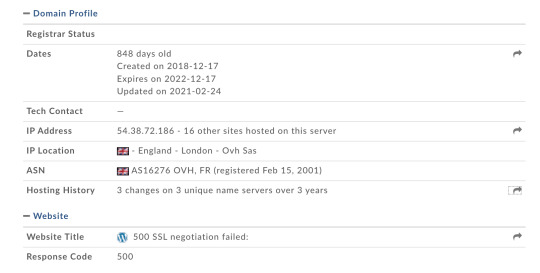
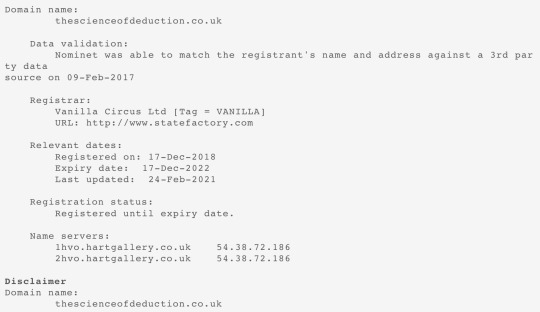
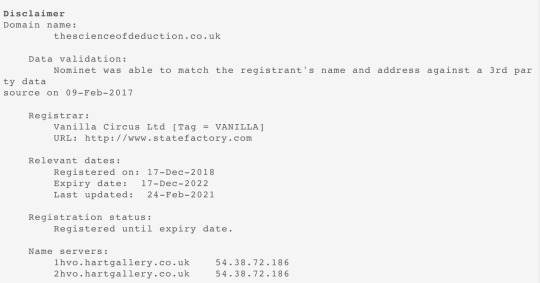
...So what we see here are all the signs that a domain has been allowed to lapse, has been bought by someone besides the BBC, and is now being revived... in some form.
But why? The only guide we have here is the names of the websites mentioned in the new registration: statefactory.com and hartgallery.co.uk.
The second of these is also a WordPress site, but as empty (at the moment) as the revived Science of Deduction site is. The first one is a company that helps sites achieve higher search engine rankings.
So what does this mean for the Science of Deduction domain? Probably that somebody’s looking to exploit (or monetize) its historical web ranking in some way. (And sure enough, when you put the domain’s name into Google Search, it comes up at the top of the page. Not unusual for a site that would have been very, very popular, back in the day...)
...Anyway (and regretfully) that’s all I’ve got for you at the moment. If I find out anything more useful or illuminating, I’ll append it here.
ETA 1: Those concerned about the preservation of the original content of the sites -- please note that both of them have mirrors on Tumblr, at https://thescienceofdeduction-co-uk.tumblr.com/ and https://johnwatsonblog-co-uk.tumblr.com/ .
ETA 2: Had a set of questions come along from @garkgatiss and wanted to deal with them here, as it’s less unwieldy than handling them in the comments. But also, the answers are of general interest.
If I'm reading this correctly, it's still not clear what is causing the loss of formatting, but it does indicate to you *some* recent fiddling has been happening with the site. Is that accurate? Or can these mystery reasons for loss of formatting include things outside of the web designer putting hands on the website?
They can. One thing that happens all the time in corporate web structure is that the locations of static/source directories get changed, and (large companies being what they are) not all the people who need to know about it are always notified: especially when the projects in question are legacy projects or have otherwise been locked down into “no further changes” mode. (Or in some cases, the people who used to handle that project have been moved to another one, and those presently in charge of the one you’re interested in may not realize that this issue is going to become, well, an issue.)
Anyway, we know this sort of lockdown has happened to johnwatsonblog.co.uk becuse the HTML of the source page clearly shows a set of instructions for a “mothball” popup to appear when the page is loaded: a text box explaining that the page is no longer being updated. ...But this by itself doesn’t explain why the page’s formatting has gone south.
A useful clue here is that this page seems (to me anyway) to take an awful long time to load: as if its code is instructing it to look for something it can’t find. (Just for curiosity’s sake, I ran it through Google’s PageSpeed tool, and that tool failed with a “try again later” error.) My first guess was that the page’s CSS file -- its set of instructions for how it’s supposed to look -- might have been moved.
When this occurred to me I pulled the address of that file out of the HTML, added the master BBC.co.uk “home address” to the front of it (as the version in the page’s source is truncated) and attempted to load it. This resulted in a “Can’t find that page, sorry” (404) page coming up. ...No real surprise there: the odds of a CSS file being so easily accessible to rando outsiders aren’t great. So the data on whether or not the CSS file has been moved is inconclusive.
However, this led me down another, potentially more revealing path. Styled or unstyled (and the BBC website’s “best practices for accessibility” resource makes it plain that a page’s content is expected to be accessible whether or not its CSS/style file is loading correctly), the page still says “For more info about this project, go to the Sherlock programme website.” And when you go there, what you find on scrolling down the site is that it clearly still links to the “The Blog of Dr. John Watson” page.
Now if I was a web page manager working for so large and (in this mode anyway) well-organized an operation as the Beeb, I’d think that leaving an active link to a page in the process of being decommissioned would be damn near anathema. If I was getting ready to decommission a page, I would put a notice on that page saying as much, but otherwise I would leave it and its links to its master page strictly alone. And when it came time for the plug to be pulled, I wouldn’t change just one thing at a time (like killing or moving the page’s style sheet while leaving the page in place). I would do everything at once... within seconds or minutes of each other, ideally. Hours, at worst. Anything else strikes me as really sloppy, and very bad practice.
So what does all this mean?
tl;dr: Damned if I know. There are too many variables in this equation that could be affecting the result. ...In the short term, I’d think that there is no reason to be sure that the “blog page” is about to go away. I’d suspect there had been some kind of error involving either (a) the CSS file or (b) the other Javascript-running page loader we see referred to in the source HTML.
Which brings us to the next question:
The domain registration expires July 7, 2021, which appears to be the anniversary of its original registration date in 2010. The other date listed is that it was last updated on July 3, 2020, which, if I had to guess, would be the registration being renewed for another year a few days before it would have expired last summer. Are domains are typically renewed on an annual basis like this? Is there any reason to believe that that wouldn't happen again this year?
Not at all. I routinely renew domain registrations only a year or two at a time when I’m not sure whether I’m going to want to keep them any longer than that. (Or when I’m short of money.) Waiting till the last minute to renew, or renewing only for short periods, isn’t necessarily a positive indicator, but neither is it necessarily a negative one.
So in short... it’s impossible to tell what this means in terms of what’s going on with the Dr. John Watson’s Blog site. Probably the safest bet at this point is for someone interested (and I suspect I know who that’s going to be...) to nose around a little in the “Contact the BBC” department of their main site and see if I can find a way to get in touch with their IT people, and ideally to whoever handles website maintenance issues like this. (And this could take a while, as there’s no telling whether or not this aspect of management is something they’ve contracted out to a third party.)
So leave it with me. I’ve got some (website-based, what a surprise...) time-sensitive stuff going on at this end of things, but when I have a few moments to breathe I’ll nose around a little and see what can be discovered.
As we used to say back in the day, “Stay tuned...” :)
321 notes
·
View notes
Quote
according to new research from cybersecurity researchers, many of these protests are neither spontaneous nor organic. Cybersecurity expert Brian Krebs and researchers at DomainTools have separately analysed web addresses including the word "reopen." And interestingly, they’ve found that many of these can be linked to domains associated with gun advocacy groups, lobbyists, and other conservative organisations.
Security Researchers Say The Reopen America Campaign Is Being Astroturfed
615 notes
·
View notes